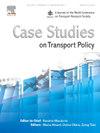Port and road network development post coastal disaster: Hurricane Ian flooding of port of Kingston, Jamaica
IF 3.3
Q3 TRANSPORTATION
引用次数: 0
Abstract
After the colossal impact of Hurricane Ian in 2022, this prompted the need to investigate the extent of the damage and, more importantly, the policies implemented to mitigate against it. That tropical storm, while passing over Jamaica, intensified into a hurricane as it hit North America in mid-September of 2022. As such, this research was conducted over the final quarter of the year 2022. As hurricanes and natural disasters morph, some regions face greater risks of flooding and a rise in sea level that occurs subsequent to it. The tropical region of the Caribbean faces these coastal disasters annually, in some cases biannually. In the Caribbean Sea, all the countries located centrally are islands. Their ports are essential as it is the only physical contact they have with each other and the rest of the world. Therefore, the damage they incur and the prevention methods must be of high importance to different regulatory bodies. This paper will analyse the frequent occurrence of natural disasters, including flooding induced by hurricanes/heavy rainfall and the rise in sea level. The way the occurrence is handled was tabulated based on a series of interviews from various governing bodies on the island. From this, the Hurricane Aftermath Evaluation Method was created, a method that holds five main variables: type of damage, extent of infrastructure damage, port downtime, impact on economy and strategies for recovery and mitigation. The study concludes that the Port of Kingston is highly susceptible to coastal disasters, and oftentimes, the infrastructure and regulatory bodies alike are grossly underprepared to combat them. Therefore, reconstruction of the drainage system must be done along with further study and improvement to the surrounding infrastructure currently in place.
沿海灾害后港口和道路网络的发展:牙买加金斯敦港的飓风伊恩洪水
在2022年飓风伊恩造成巨大影响之后,这促使人们有必要调查损失的程度,更重要的是,调查为减轻损失而实施的政策。该热带风暴在经过牙买加时,在2022年9月中旬袭击北美时增强为飓风。因此,这项研究是在2022年最后一个季度进行的。随着飓风和自然灾害的变化,一些地区面临更大的洪水和海平面上升的风险。加勒比热带地区每年,在某些情况下每半年都面临这些沿海灾害。在加勒比海,所有位于中心的国家都是岛屿。他们的港口至关重要,因为这是他们彼此之间以及与世界其他地方唯一的物理联系。因此,它们所造成的损害和预防方法必须引起不同监管机构的高度重视。本文将分析频繁发生的自然灾害,包括飓风/强降雨引起的洪水和海平面上升。处理这一事件的方式是根据岛上各理事机构的一系列采访制成表格的。由此,创建了飓风后果评估方法,该方法包含五个主要变量:破坏类型、基础设施破坏程度、港口停机时间、对经济的影响以及恢复和减灾战略。研究得出的结论是,金斯敦港极易受到沿海灾害的影响,而且基础设施和监管机构往往都没有做好应对灾害的准备。因此,必须对排水系统进行改造,同时对周围现有的基础设施进行进一步的研究和改善。
本文章由计算机程序翻译,如有差异,请以英文原文为准。
求助全文
约1分钟内获得全文
求助全文

 求助内容:
求助内容: 应助结果提醒方式:
应助结果提醒方式:


